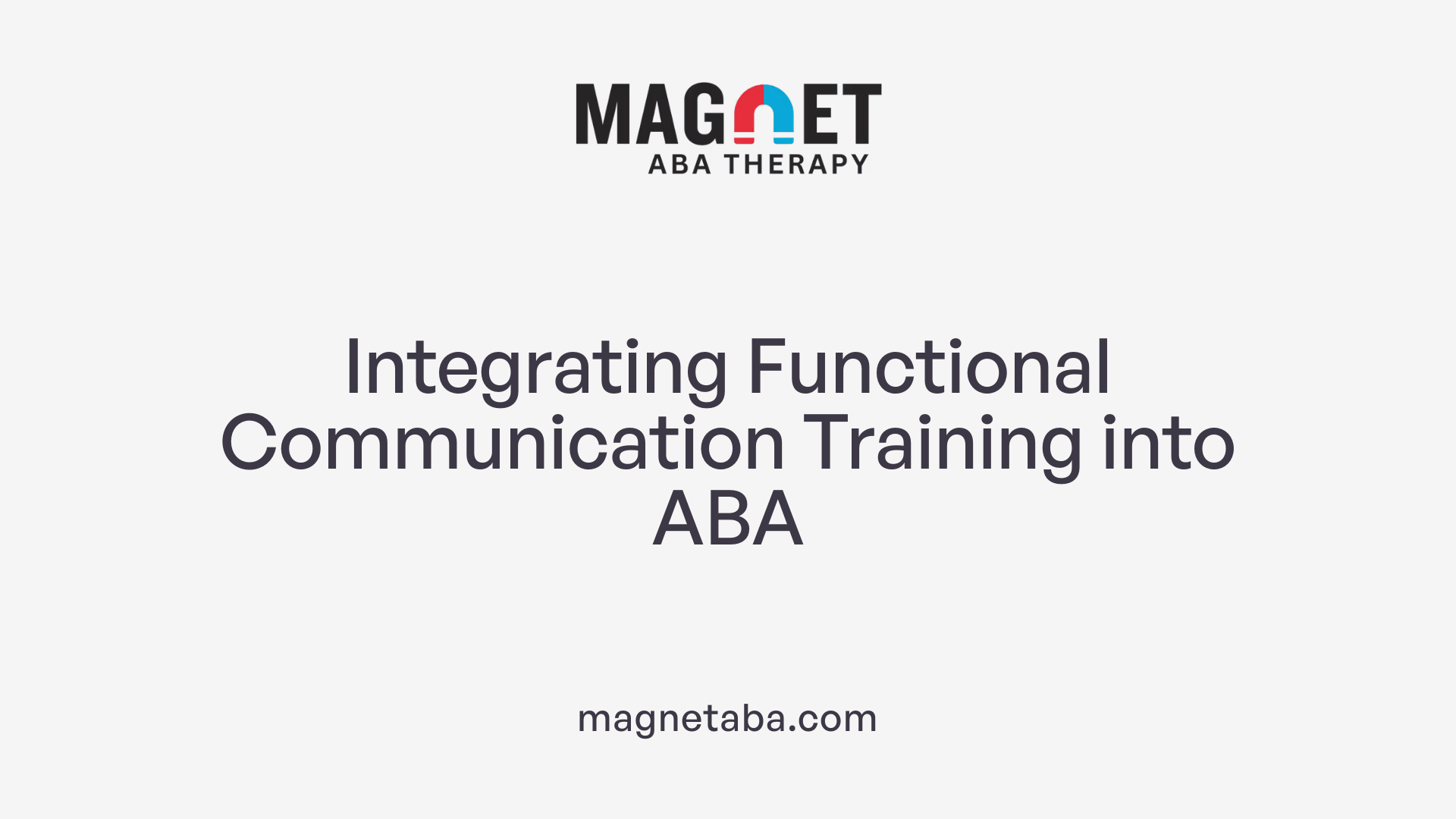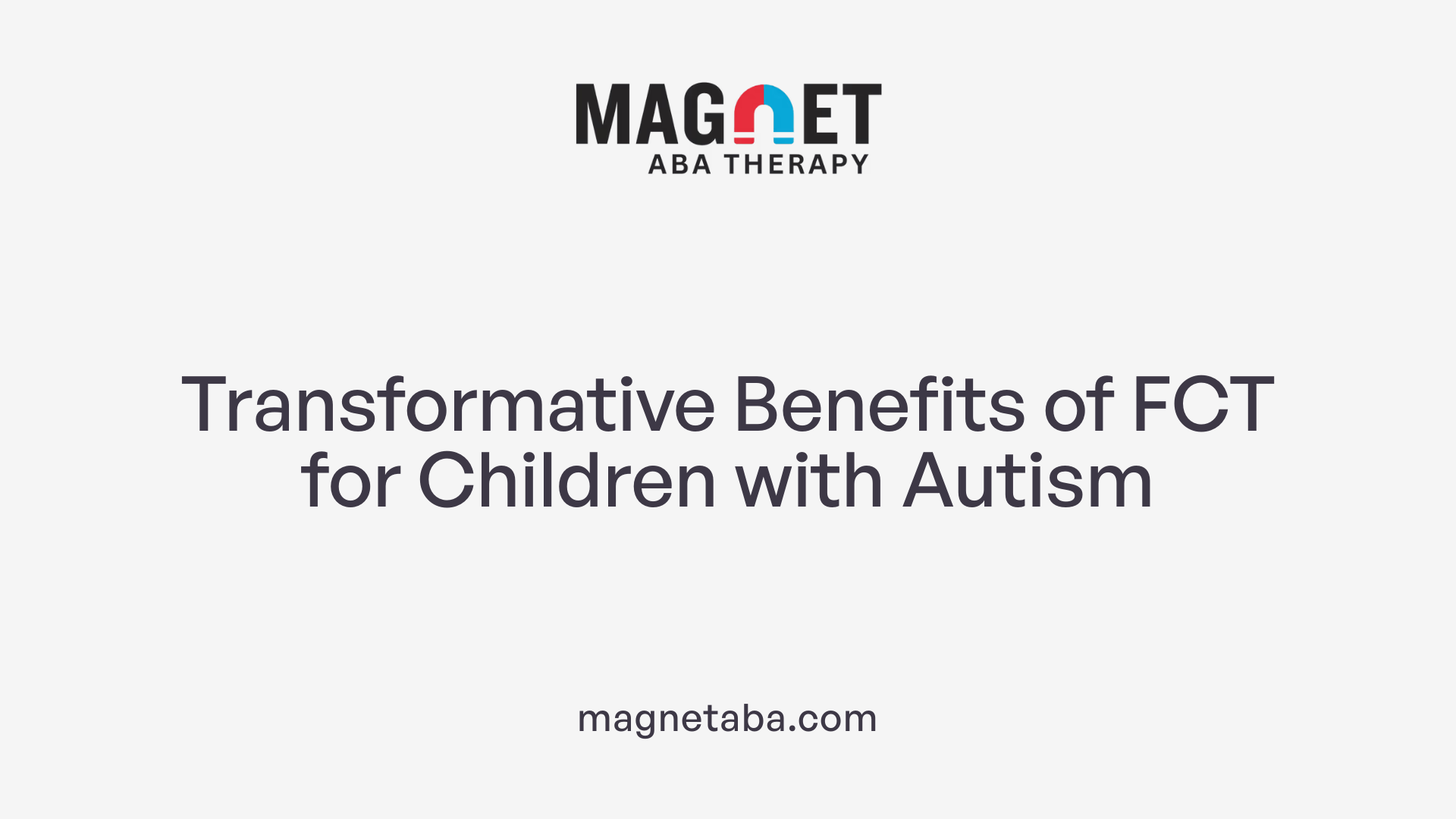Bridging Communication Gaps in Autism Through Evidence-Based Strategies
Functional Communication Training (FCT) is a specialized, evidence-based intervention integral to Applied Behavior Analysis (ABA) therapy, aimed at helping individuals with autism spectrum disorder (ASD) develop meaningful and functional communication skills. This approach not only reduces challenging behaviors but enhances quality of life by empowering children with autism to express their needs effectively. In this article, we explore the fundamentals of FCT within ABA, its implementation, benefits, and how caregivers and professionals work together for optimal outcomes.
What is Applied Behavior Analysis Therapy and Its Role in Supporting Autism?

Definition of ABA Therapy
Applied Behavior Analysis (ABA) therapy is a scientifically backed method used to help individuals with autism spectrum disorder (ASD) improve communication, social skills, and daily functioning. It focuses on understanding behaviors by analyzing what happens before, during, and after them — often called antecedents, behaviors, and consequences (the A-B-Cs).
How ABA Analyzes Behavior
ABA uses detailed functional behavioral assessments to identify the reasons behind behaviors. By determining what triggers and reinforces certain actions, therapists can tailor interventions that encourage desired behaviors and reduce problematic ones.
ABA Techniques and Goals
ABA employs methods like positive reinforcement, prompting, and structured teaching such as discrete trial training (DTT) or naturalistic approaches like pivotal response treatment (PRT). The goal is to teach meaningful, functional skills that are socially significant, helping individuals communicate effectively and participate more fully in everyday life.
ABA's Impact on Individuals with Autism
Extensive research supports ABA’s effectiveness in enhancing independence and reducing challenging behaviors in children and adults with autism. Its flexible nature allows for personalized programs led by qualified professionals, making it a cornerstone therapy that improves quality of life and supports long-term success.
Introducing Functional Communication Training Within ABA Therapy

What is Functional Communication Training (FCT)?
Functional Communication Training (FCT) is a specialized teaching process that aims to help children with autism spectrum disorder (ASD) and other developmental disorders develop meaningful and functional communication skills. By teaching alternative communication responses, FCT seeks to replace difficult behaviors such as aggression, self-harm, or non-compliance with socially acceptable communication methods like gestures, sign language, or picture exchange systems (PECS). This process alleviates frustration and anxiety that often result from communication difficulties.
What Are the Core Principles of FCT?
The core principles of FCT revolve around understanding and addressing the function behind challenging behaviors. It starts with conducting detailed functional behavior assessments to identify environmental reinforcers maintaining the problem behaviors. FCT then teaches alternative communication behaviors that achieve the same outcomes, such as gaining attention, escaping undesirable situations, or accessing preferred objects. Techniques used include prompting, differential reinforcement, and social stories to encourage consistent use and generalization of communication skills across different settings and people.
What Is the History and Foundation of FCT?
FCT was first described in 1985 by Carr and Durand, emphasizing that many challenging behaviors seen in individuals with autism serve as forms of nonverbal communication. Since then, FCT has become one of the most thoroughly researched and supported interventions for behavior problems in developmental disabilities. It is grounded in behavior analytic principles and utilizes evidence-based practices, such as functional behavioral assessments and differential reinforcement, to systematically replace problem behaviors with meaningful communication.
How Does FCT Complement ABA Therapy?
Applied Behavior Analysis (ABA) therapy focuses on teaching new skills and modifying behaviors by analyzing antecedents, behaviors, and consequences in real-life contexts. FCT complements ABA by focusing specifically on communication as a vital skill to reduce disruptive behaviors. Within ABA, therapists perform functional behavioral assessments to understand why challenging behaviors occur and then apply FCT techniques to teach effective communication that serves the same function. This integration enhances communication, social skills, and overall behavior, leading to improved independence and quality of life for children with autism.
The Process and Techniques of Functional Communication Training

What is Functional Behavioral Assessment in FCT?
Functional Communication Training (FCT) always begins with a thorough functional behavioral assessment (FBA). This assessment helps identify why a child engages in challenging behaviors by uncovering the functions those behaviors serve—such as gaining attention, escaping demands, or obtaining materials. By understanding these triggers and reinforcers, therapists can design interventions tailored to the child’s unique needs.
How are Communication Methods Selected?
Once the behavioral function is identified, appropriate communication responses are selected. These responses aim to replace difficult behaviors with socially acceptable communication. Options include gestures, sign language, and picture exchange systems (PECS), among others. The choice depends on the child's communication abilities and needs. For example, a non-verbal child might benefit from PECS or simple gestures, while a child with some verbal skills could learn sign language or vocal requests.
What Teaching Strategies Are Used?
FCT employs various teaching strategies to help the child acquire new communication skills. Prompting is used initially to guide the child’s responses, followed by prompt fading to encourage independent use of communication. Shaping gradually refines the communication skills by reinforcing closer approximations to the target behavior. Reinforcement plays a crucial role; positive reinforcement is delivered immediately when the child uses the functional communication, thereby motivating further use.
How Are Extinction and Reinforcement Thinning Applied?
In addition to teaching communication responses, FCT often incorporates extinction, where the difficult behaviors no longer produce their previous outcomes or reinforcers. This helps reduce these problem behaviors over time. Reinforcement schedules start as continuous, meaning every appropriate communication attempt is reinforced. Later, reinforcement thinning occurs by reinforcing responses less frequently but consistently enough to maintain the new behaviors in natural settings.
Through these processes—functional assessment, careful communication method selection, systematic teaching strategies, and strategic reinforcement adjustments—FCT effectively builds functional communication skills and reduces challenging behaviors in children with autism and developmental disorders.
Benefits of Functional Communication Training for Children with Autism

Reduction in challenging behaviors
Functional Communication Training (FCT) is highly effective in reducing challenging behaviors common in children with autism, such as aggression, tantrums, self-harm, and non-compliance. By teaching alternative and socially acceptable communication methods—like gestures, sign language, or picture exchange systems (PECS)—FCT replaces disruptive actions with meaningful ways to express needs. This alleviates frustration and anxiety that often lead to difficult behaviors.
Improvement in communication and social skills
FCT helps children develop meaningful communication skills, improving their ability to interact socially. This enhancement in communication not only reduces problem behaviors but also supports growth in play and school readiness. By focusing on methods tailored to the child's abilities, including verbal requests or alternative communication devices, FCT builds stronger, more effective social connections.
Increased independence and quality of life
Children taught through FCT experience greater independence as they acquire skills to express themselves appropriately across various settings. The training promotes consistent use of communication tools, empowering children to meet their needs and desires effectively. This leads to an improved quality of life and reduces caregiver stress by fostering better relationships and smoother daily routines.
Evidence base and age range applicability
FCT is an evidence-based practice supported by numerous studies and systematic reviews, demonstrating large effects in decreasing problem behaviors and increasing communication skills. It is effective across a wide age range, from young children (3 years old) through young adults (up to 22 years). Treatment task forces widely endorse FCT as a medically necessary and empirically supported intervention for individuals with autism and developmental disabilities.
The Role of Professionals and Caregivers in Successful FCT Implementation

Who provides ABA therapy and what qualifications do professionals need?
ABA therapy, including Functional Communication Training (FCT), is delivered by trained professionals like Board Certified Behavior Analysts (BCBAs) and Registered Behavior Technicians (RBTs). BCBAs require at least a bachelor's degree in psychology or a related field, further advanced training through master’s programs, and certification via the Behavior Analyst Certification Board (BACB). This involves passing a comprehensive exam and completing supervised practical experience. RBTs undergo shorter, focused training and assessment processes. Many regions also demand licensure or registration to maintain specific educational and ethical standards. These credentials ensure that ABA practitioners have the expertise to apply evidence-based interventions effectively.
How can parents and caregivers support effective ABA therapy for their loved ones with autism?
Caregivers have a vital role in the success of FCT within ABA therapy. They collaborate closely with professionals to implement tailored strategies that align with daily life, promoting skill retention and behavioral improvements. Consistent reinforcement by parents, adherence to routines, and applying learned communication techniques across home, school, and community settings help generalize new skills.
Training sessions equip caregivers with the tools and confidence needed to deliver interventions correctly and support behavioral goals. Their encouragement provides emotional support and motivation for the child, fostering an environment encouraging growth and independence. Such active participation enhances therapy outcomes and strengthens familial bonds.
Consistency and generalization across environments
A cornerstone of FCT success is maintaining consistent implementation across different settings and caregivers. Therapy gains are maximized when everyone involved—the ABA team, family members, and educators—consistently uses the same communication methods, prompts, and reinforcement techniques. This promotes skill generalization, ensuring children apply functional communication in various social contexts and everyday situations.
Training and ongoing progress monitoring
Professionals guide caregivers through ongoing training, including modeling techniques such as prompting and reinforcement strategies. Progress monitoring allows the ABA team to evaluate the child's development, adjust intervention plans, and support caregivers in overcoming challenges. This dynamic partnership ensures that FCT evolves to meet the child’s changing needs and maximizes long-lasting positive outcomes.
A Typical ABA Therapy Session Incorporating Functional Communication Training
Session Structure and Activities
A typical ABA therapy session incorporating Functional Communication Training (FCT) starts with the therapist assessing the child's current communication and behavior skills. This initial observation helps identify specific goals tailored to the child's needs. The session then progresses through structured activities such as communication exercises using gestures, sign language, or Picture Exchange Communication System (PECS), alongside play and social skills training. Visual aids and prompts are commonly used to support learning and engagement.
Use of Positive Reinforcement and Data Collection
Positive reinforcement plays a central role in ABA sessions with FCT. Therapists consistently reward desired communicative responses with praise, tokens, or access to preferred activities. This reinforcement encourages the child to replace challenging behaviors like tantrums or aggression with socially acceptable communication methods. Meanwhile, therapists collect detailed data on the child's behavior and communication attempts throughout the session, enabling ongoing evaluation and adaptation of teaching strategies for optimal progress.
Parent and Caregiver Collaboration During Sessions
Collaboration with parents and caregivers is integral to the ABA session. Therapists involve caregivers in the process by demonstrating communication techniques and providing strategies to reinforce the new skills consistently at home. This partnership ensures generalization of functional communication across settings and helps maintain treatment gains beyond therapy sessions.
Examples of Communication Skill Exercises
Examples of FCT exercises used during the session include practicing requests through picture cards, signing simple words, or using gestures to express needs like "more" or "help." The therapist may use prompting and gradual fading techniques to encourage independent communication. Social stories and visual schedules can also be integrated to enhance understanding and use of appropriate communication in daily routines.
Embracing Functional Communication Training to Enhance Lives
Functional Communication Training stands as a pivotal component of ABA therapy, offering hope and practical tools for children with autism to overcome communication barriers and reduce challenging behaviors. Through meticulous assessment, tailored teaching methodologies, and a collaborative approach involving both professionals and caregivers, FCT fosters meaningful communication that can transform daily interactions and long-term outcomes. As research continues to support its effectiveness, implementing FCT remains essential for promoting independence, social engagement, and improved quality of life for individuals with autism and their families.
References
- What is Functional Communication Training?
- Functional Communication Training: A Review and ...
- Functional Communication Training (FCT) in ABA Therapy
- Bridging the Gap: Functional Communication in ABA
- Functional Communication Training (FCT)
- What is Functional Communication Training?
- How to Become an Applied Behavior Analyst (ABA) Therapist
- How to Become an ABA Therapist - School of Education
- Board Certified Behavior Analysts (BCBA)











